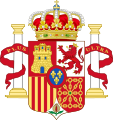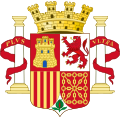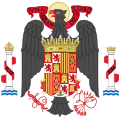Coat of arms of Spain
| Coat of arms of Spain | |
|---|---|

|
|
| Details | |
| Introduced | October 19, 1981 |
| Shield shape and division | Spanish shield, square with grafted-in tip , oval heart shield |
| Heraldic shield | 1. Castile , 2. León , 3. Aragón , 4. Navarre , and Granada ; Heart Bourbon Anjou |
| Crown of rank | Royal crown of Spain |
| Sign holder | Pillars of Heracles with banner |
| Motto (motto) | Plus ultra |
| Previous versions |
See section historical forms
Kingdom of Spain around 1600 (Siebmacher 1605)
|
The coat of arms of Spain ( Spanish Escudo de España ) has been valid as the national coat of arms since 1981.
description
The blazon of the coat of arms of Spain is regulated by Law 33/1981 of October 5th, 1981; The Royal Decree of December 8th of the same year contains an illustration of the coat of arms. Another decree of September 3, 1982 regulates the exact coloring.
- The coat of arms of the Spanish national coat of arms shows the traditional components of the kingdom. It is identical to the coat of arms of the King of Spain.
- The oval heart shield shows the coat of arms of the ruling house of Bourbon-Anjou .
- The coats of arms of the historical sub-kingdoms are arranged all around.
- The royal crown of Spain ( corona real ) symbolizes the Spanish monarchy.
- The pillars of Herakles frame the coat of arms in the function of a shield holder and symbolize both the geographical location of Spain on the Strait of Gibraltar and its overseas orientation. They were added to the coat of arms by Emperor Charles V , who was King of Spain as Charles I.
- The columns are connected by a red banner with the Latin motto Plus Ultra (“beyond” or “always further”) - Charles' motto, under whose rule Spain became a world empire.
- The pillars are crowned heraldically on the right by the so-called "imperial crown" ( corona imperial ) of the Spanish Empire and on the left by the royal crown of Spain.
The Spanish coat of arms can also be found on the flag of Spain , while it is absent on the civil and commercial flag .
Importance of the components
|
|
Crowning | Royal crown |

|
columns | Pillars of Heracles with the banner "Plus Ultra" |
- According to one theory, the symbol for the peso ( $ ) developed from a stylized representation of these two pillars with the banner. Later it was u. a. transferred to the US dollar.
The coat of arms fields represent the medieval kingdoms from which the Spanish monarchy emerged:

|
1st field | (heraldic) at the top right a golden castle on a red background, the coat of arms of the Kingdom of Castile |

|
2nd field | Coat of arms of the Kingdom of León , a purple lion on a silver background |

|
3rd field | Four red posts on a gold background for the Aragon Crown |

|
4th field | Golden chains on a red background for Navarre |

|
top | A green leafed pomegranate on silver for the former Kingdom of Granada |

|
Heart shield | In the heart shield you can see three golden irises on a blue background, the family coat of arms of the Bourbons , who represent the kings of Spain. |
Historical forms
During the time of the Catholic Kings , the St. John's eagle formed the shield holder, which was included in the coat of arms as Queen Isabella's personal heraldic animal . Karl I./V. replaced it with the double-headed imperial eagle of the Holy Roman Empire . With his accession to the throne, the chain of the Burgundian house order from the Golden Fleece was included in the coat of arms, of which Karl was master of the order. To this day, the shield of the coat of arms of the kings of Spain is hung with this chain.
- Late 15th century: Catholic kings
- 16th century: Charles I.
- 16th century: Philip II.
- 16th and 17th centuries: Spanish Habsburgs
Coat of arms of the kings of the
House of Habsburg (Casa de Austria)
1599–1668
- 18th century: House Bourbon (again in the 19th and 20th centuries)
Large coat of arms of
the kings of the
House of Bourbon
1700–1761Small coat of arms of the
Bourbon kings
Pillars of Heracles
1761–1808
1812–1868
1874–1931
- Early 19th century: Bonaparte
Large coat of arms of Joseph I.
Napoleonic eagle
in the heart shield
1808–1812Small coat of arms of Joseph I.
Golden Fleece
Legion of Honor
scepter
- 19./20. Century: First Republics, House of Savoy , House of Bourbon, Second Republics
National coat of arms of Spain:
Provisional Government
1869–1870
First Republic
1873–1874
Coup in
1874National coat of arms of Spain Amadeus I
Savoy in the heart shield
1870–1873National coat of arms of Spain's
Second Republic
1931–1939
- Middle 20th century: Franquism
National coat of arms of Spain from the Franco era
1939–1945National coat of arms of Spain, transition
phase 1977–1981
During the Franco regime, various, mostly historicizing changes were made to the shape of the Spanish national coat of arms, which lasted until 1981; Most noticeable was a black eagle, which resembled the St. John's eagle and stood for Casticismo , which was associated with the Catholic Monarchs in the ideology of Franquism .
See also
- Spanish heraldry , about the specifics of heraldry in Spain
literature
- Karl-Heinz Hesmer: Flags and coats of arms of the world. History and symbolism of the flags and coats of arms of all states. Bertelsmann Lexikon Verlag, Gütersloh 1992, ISBN 3-570-01082-1 .
Web links
- Flag lexicon (description of flag and coat of arms)
- The coat of arms of the Spanish royal family
Individual evidence
- ↑ Ley 33/1981, de 5 de octubre, del Escudo de España (official text of the blazon).
- ↑ Real Decreto 2964/1981, de 18 de diciembre, por el que se hace público el modelo oficial del Escudo de España (official text).
- ↑ Real Decreto 2267/1982, de 3 de septiembre, por el que se especifican técnicamente los colores del Escudo de España (official text).






























